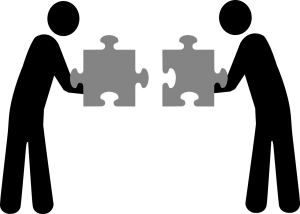Hunting for less than half the story
When I was early in my years as an in-house lawyer, I was called upon to write an agreement that covered a complex relationship between the company that employed me and its joint venture partner. As with many joint ventures, this was a custom arrangement. I could not go the files, pull out a similar agreement, mark it up, and have what I needed. I had to draft most of the agreement from scratch.
If you are not a lawyer, this may sound a bit strange. Many clients believe that lawyers have by now written agreements that cover every type of arrangement out there. The key is finding the agreement comparable to your client’s situation and making the changes needed to make the fit. Lawyers know that belief is untrue.
There are, of course, many types of agreements and lawyers do in fact have models for many situations. But, especially in complex commercial situations, we still draft from scratch (or mostly so). I started with the bare bones of a joint venture agreement and begin writing.
Writing a new agreement involves dozens, hundreds, even thousands of decisions. You must ask at each step whether to include something, how detailed to go, and whether you have or need to address the “fertile octogenarian.” For those who did not have the pleasure of taking estates and trust in law school, the last reference may be a bit oblique — let me explain.
When drafting a will, you want to cover all the contingencies. It is not enough to say your earthly possessions will be split amongst your children, because one or more of your children may predecease you. Worse yet, that child may die childless, or your grandchildren through that child may predecease you and your child. The combinations seem endless.
The fertile octogenarian concept refers to the 80 year old who decides to start a new family with his young bride. At age 80, he has one (or more) children. Unusual, but possible. So the will drafter must try to cover all the contingencies so the will does not leave any gaps.
When drafting a contract, you must ask a similar question. Do you try to cover all the gaps? Do you knowingly leave gaps? Which gaps are okay to leave? The reality is that you cannot draft a contract detailed enough that it covers all possibilities; you will always have gaps.
All throughout the drafting, you make decisions about what goes in and what goes out. You do not make them in a vacuum. Some you make after discussions with your client; others come after negotiations with the other party to the agreement. Sometimes, you refer to documents (such as the operating rules the parties have drawn up) for inspiration. Each discussion, each document you review, adds to the database that surrounds the agreement.
Finally, you are done. Both parties sign the agreement and, if you are lucky, copies go into files and the parties enjoy a long and prosperous relationship. More likely, some time passes, the parties grow less fond of the relationship, and it comes to an end by agreement or by force.
The Missing Knowledge
Years pass and your carefully drafted agreement sits in the files. Then, someone decides it should be in the “knowledge management” system along with thousands of other documents. Using machine learning, the documents are assembled electronically, sliced and diced, and now everyone can stumble upon what you wrote.
Is this knowledge management? To answer that question, go back to my drafting story. While my drafting experience with that agreement may seem extreme, the basics were not unusual. Each agreement has its own story. What the drafters put in, what they kept out, and how they crafted each provision is informed by discussions, emails, documents, and other data that no one captured. All you have is the final product, not the context. Artificial intelligence will have trouble finding the record that does not exist.
Law firms and law departments share this problem. They all have thousands upon thousands of end products without the stories. When the lawyers drafted the documents, no one thought (assuming the technology was up to the challenge) to capture the stories. So they have what but not why.
Assuming one can fill in the gaps in a story by looking at the final product, or even drafts along the way plus the final product, is risky. A lot goes into the process. In some cases, lawyers may include provisions that they believe a court will not enforce, but the law is unclear and the opposing party demands inclusion of the provision. Quirks like this exist throughout documents.
An agreement may include a clause enforceable in one state, but not another. Which state’s law will apply to a dispute has been left open. Sometimes, both lawyers working on the agreement were mistaken as to the law (it happens). And, of course, there are gaps. Some of the gaps are intentional, some unintentional, but you don’t know which is which.
Your paper (digital) record is at best a very incomplete part of the story, and a dangerous one at that. The question is not whether you have an incomplete record, it is what do you do with that record?
Current Knowledge Management Is Archeology
At this point, you are the archeologist. The question is not whether you search for the artifacts, the question is how to interpret what you find. When you unearth the pile of shards from clay pots, did you find the garbage dump, a storage depot, or the place where the clay pots were made? What do the pots tell you? You know the questions are hard and unanswerable, but you still look for the pots.
Gaps in the historical record of legal services are all around us. One example is the documents sitting on our computers. Another is case law. We know what the judge (or clerks) choose to tell us in the opinion, but that is all. We do not know what was in the case record, or what the judge looked at on the Internet.
We have another huge gap in our historical record. Every client who called with a question, or participated in a conference, receiving oral advice but no documents leaves a void in the database. This gap is not inevitable. Customer service representatives record notes in databases creating an historical archive of how they handle customer problems. We can mine those archives for ways to respond to future questions. Lawyers simply chose to leave the record blank.
Become The Puzzle Master
We have wonderful tools today for mining the data we did keep. The obvious challenge is knowing how and when to use what we learn. But, the bigger challenge is in recognizing that the future belongs to those who collect the data. How do we increase the capture rate and combine that with the documentary record to broaden the story? How do we create ecosystems rather than islands?
Innovators look for ways to solve vexing problems. When you go to your next meeting on “knowledge management” remember that you aren’t really managing knowledge, you are trying to reconstruct a puzzle without most of the pieces. Capturing more pieces for the future should be a big part of your focus. Become the puzzle master.
Editor’s Note: This article is republished with the permission of the author, with first publication in The Algorithmic Society.


